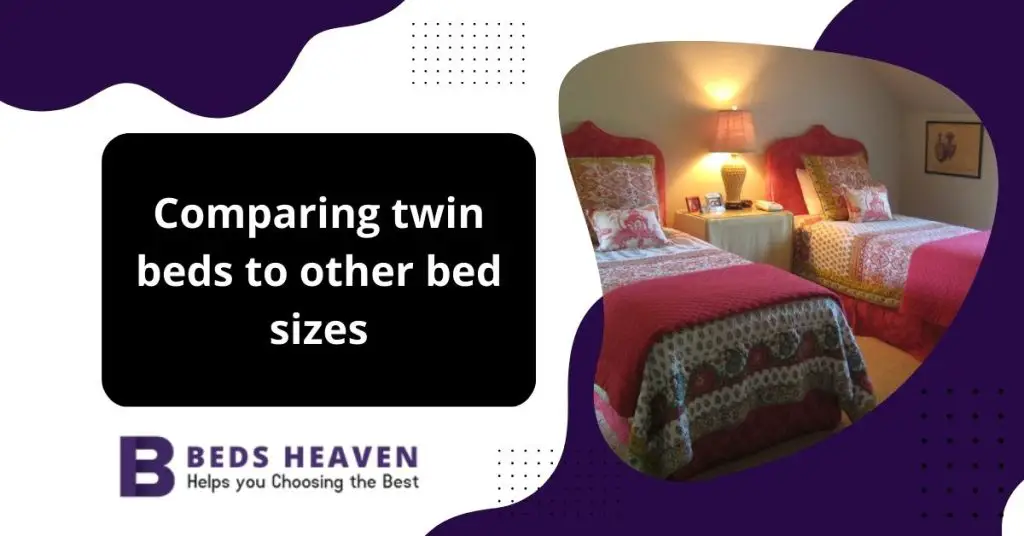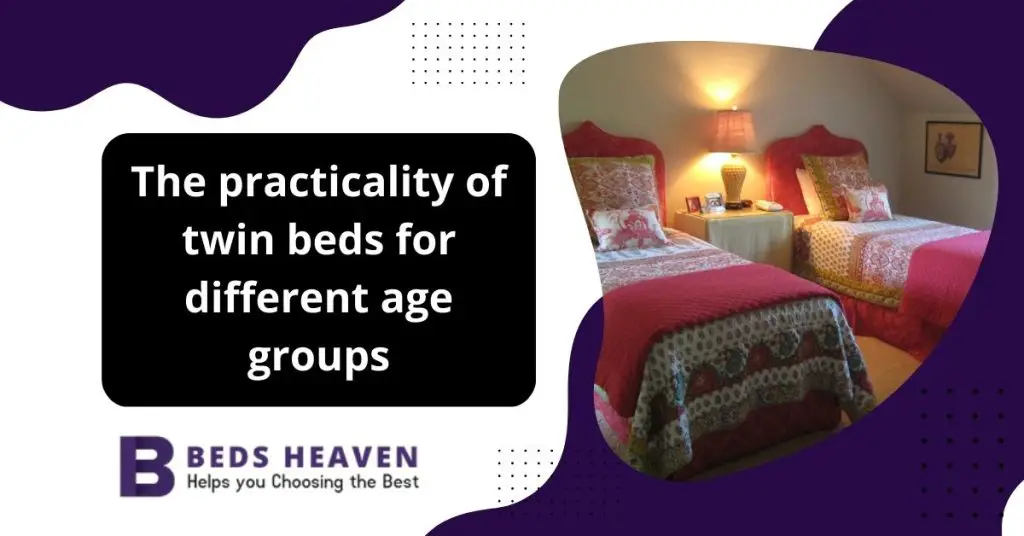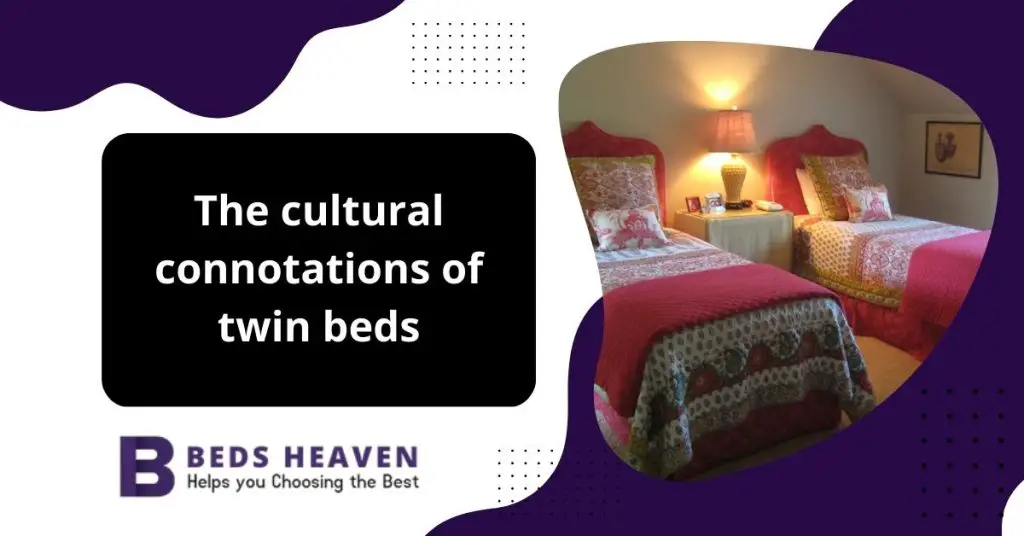Last updated on February 14th, 2023 at 09:55 am
A twin bed is called a twin because it’s designed to accommodate one person, which is often associated with the concept of having a twin. Learn more about the history and origin of the term “twin bed” in this informative article.
Introduction
Quick Links
Twin beds are designed to accommodate one person and are one of the most commonly used bed sizes in the US. If you’ve ever wondered why these beds are called twins, you’re not alone.
It is unclear how the term “twin” originated, but a few theories have been proposed to explain how it became associated with a single-size bed. The purpose of this article is to shed some light on this interesting piece of trivia by exploring the possible origins and meanings of the term “twin bed”.
Why is a Twin Bed Called a twin?

When it comes to simple, space-saving sleeping solutions, twin beds are a popular choice. Have you ever wondered why they are called twin beds? We will examine the origins and theories behind why a twin bed is called a twin bed in this article. Although they are designed to accommodate one person, their naming convention seems odd.
1. Possible origins of the name “twin bed”
There are a few theories that attempt to explain the origin of the name “twin bed.” One possibility is that the term “twin” refers to the idea of having two of something, such as a pair of shoes or gloves. In the case of twin beds, it’s thought that the name refers to the idea of having two of these beds in a single room, which was a common practice in the past.
A second theory holds that the name “twin bed” was inspired by the fact that these beds were originally used for children, especially twins. In support of this theory, parents may choose to purchase two twin beds to accommodate twins or siblings who share a room since twin beds are often used in children’s rooms.
2. The evolution of the twin bed
As the name “twin bed” has been associated with beds for decades, their design has evolved over the years. Early twin beds were typically designed to be pushed together to form larger sleeping surfaces, similar to king-sized beds. Nevertheless, as the popularity of larger beds increased, twin beds were increasingly designed and marketed as standalone beds that could be used by individuals.
The twin bed is a popular choice among children’s rooms, guest rooms, and college dormitories due to its compact size and versatility. Today, twin beds come in a wide variety of styles and designs, from traditional box springs and mattresses to modern platform beds with storage built-in.
Final Words
While the origins of the name “twin bed” are unclear, the theories behind it provide an interesting insight into the history and evolution of this popular bed size. Even though they are referred to as twin beds, they are a great sleeping solution for a single sleeper who wants something compact and practical to sleep on. Whether you’re a parent with twins, a college student on a budget, or simply in need of a space-saving bed, a twin bed may be the ideal choice for you.
Comparing twin beds to other bed sizes

Although twin beds are the most common bed size, they are not always the best option for everyone when choosing a bed. When it comes to selecting the appropriate bed for your needs, understanding how twin beds differ from other sizes can help you make an informed choice.
1. Full Beds
There is a difference between a full bed and a queen bed, which is 54 inches wide and 75 inches long, which is larger than a twin bed and smaller than a queen bed. It is typical for a single person to have a full bed, or for a couple to not require much space. They are also a good option for guest rooms since they offer sufficient room to sleep comfortably for two people.
2. Queen Beds
The 60-inch wide and 80-inch long queen beds are a popular choice for couples who wish to spread out while sleeping. They are 6 inches wider and 5 inches longer than full beds. Furthermore, queen beds can be used by people who like to have their pets or children sleep with them since there is ample space for all of them to sleep comfortably.
3. King Beds
The king bed has a width of 76 inches and a length of 80 inches, making it the largest of the common bed sizes. A king bed provides a lot of space for couples, as well as those who enjoy reading, watching television, or working on their laptops while lying in bed. For those with larger bedrooms and who wish to have their bed as the focal point of their room, king beds are also an excellent option.
Final Words
This bed size is 38 inches wide by 75 inches long compared to these other bed sizes. Due to their smaller size, twin beds are ideal for children, teens, or young adults who live in smaller spaces, such as dorms or apartments. Additionally, they can be used as daybeds in a home office or den for guests.
It is important to consider the intended use of the bed before making a final decision about twin beds, even though they are often considered the most affordable and practical option. Twin beds may be ideal for children or guests. To ensure that you have enough space to sleep comfortably, a full, queen, or king bed may be a better option for you if you are looking for a bed for yourself or your partner.
The practicality of twin beds for different age groups

It is important to consider a variety of factors when choosing a bed, such as size, comfort, and durability, but the age of the person who will be sleeping in it is also important to consider. Despite their reputation as practical options for children, twin beds can also be an excellent choice for teenagers, college students, and adults. In this article, we will explore the practicality of twin beds for different age groups.
1. Children
There are several reasons why twin beds are popular in children’s bedrooms.
- The first is that they are smaller in size, making them an excellent choice for smaller bedrooms.
- The second reason is that they are often less expensive than larger beds, making them ideal for parents on a budget.
- Third, twin beds are ideal for young children just starting to sleep in their own beds.
- Furthermore, it is important to consider the durability of the bed, since children are active and may use the bed as a trampoline or jump on it.
2. Teenagers
Some teenagers may prefer a bed that is larger than a twin bed as they grow up, but for some teenagers, a twin bed can still be a practical option. In the case of a small bedroom or limited space in the home, a twin bed may be the only option. Additionally, if the teenager lives in a dorm room, a twin bed may be the standard size for the room. As teenagers may use their beds for activities such as studying, reading, or talking with friends, it is important to consider the durability of the bed as well.
3. College Students
A twin bed is a practical option for college students for several reasons, as they are usually smaller than a full bed. As a result of their small size, college students often live in dorm rooms.
- The first reason for this is that they are less expensive than larger beds, so they are ideal for students on a budget.
- The second reason is that they are easy to move and transport, which is especially important for students who often move.
- As a result, they are a standard size, which makes it easy for students to purchase bedding and other accessories.
4. Adults
While twin beds may not be the first choice for adults, they can still be a practical option in certain situations. Considering that an adult may have limited space in an apartment or studio, a twin bed may be the only option for them.
Moreover, a twin bed may be more cost-effective for adults who reside alone and do not require much space to sleep. In addition to comfort and durability, it is important to consider the needs of adults, since their needs may differ from those of children or teenagers.
Final Words
Different age groups find twin beds to be an appropriate choice. A twin bed can be an excellent alternative for parents looking for beds for their children, college students living in dorm rooms, or adults living in small spaces. When choosing a bed, regardless of your age, it is important to consider factors such as size, comfort, and durability.
The cultural connotations of twin beds

Around the world, twin beds, commonly referred to as single beds, are a popular choice for bedrooms. Although they are often associated with children or smaller spaces, they also have a variety of cultural significance depending on where they are located. The purpose of this article is to examine the cultural connotations associated with twin beds throughout the world.
1. United States
Children’s bedrooms are often associated with twin beds in the United States. Twin beds are a popular choice for parents who want to provide a comfortable and practical sleep environment for their children. However, twin beds also have a cultural connotation associated with the concept of “separate beds.”
While this practice has largely fallen out of favor, twin beds still have a cultural connotation that they are separate beds. Couples can sleep in separate beds during the mid-20th century, but this practice has largely fallen out of favor today.
2. Japan
The traditional Japanese sleeping arrangement is the futon, which is a type of mattress placed on the floor, rather than a twin bed. Twin beds are less popular in Japan than they are in the United States. However, over the past few years, twin beds have gained in popularity, particularly in hotels and other tourist venues. In Japan, twin beds are often associated with the concept of “Western-style” living, regarded as modern and sophisticated.
3. Europe
As a practical solution to accommodating two people within a smaller space, twin beds are a popular choice in European guestrooms or hotels. However, they also have a cultural connotation associated with the individualism that is associated with twin beds.
Having your own bed is a common practice in many European cultures, whether you are married or in a long-term relationship. This is viewed as a method of maintaining individuality and personal space within a relationship.
4. India
Traditionally, Indian bedrooms do not consist of twin beds. Instead, they consist of charpoys, which are beds constructed from woven rope or string. The use of twin beds has gained in popularity in recent years, particularly in urban areas where Western-style living is more prevalent. A twin bed is often associated with modernity and sophistication in India, particularly among the younger generation.
Final Words
While twin beds are often associated with children’s bedrooms or small spaces, they can also be viewed as a practical solution for accommodating two people. Their cultural significance may vary according to the region.
Depending on the region, twin beds have cultural connotations that indicate individualism, modernity, and sophistication. The significance of twin beds around the world can be better understood by understanding their cultural connotations.
Why is a twin bed smaller than a double bed?

There are several reasons why twin beds are typically smaller than double beds.
- First and foremost, twin beds are designed for use by one individual, whereas double beds are meant for use by two individuals. Therefore, twin beds must be smaller to accommodate one person comfortably.
- Moreover, twin beds are typically used in smaller bedrooms, while double beds are typically used in larger rooms. This is because twin beds take up less space than double beds, making them ideal for small bedrooms.
- Finally, twin beds are generally more affordable than double beds, which may account for their smaller size.
How to use a twin?

When using a twin, it is essential to keep a few things in mind:
- Twins can be used for many different purposes, so you should determine what you will use them for before purchasing them.
- Twins have great versatility and can be used in various ways, so creativity is essential when using them.
- Twins are a great way to add a unique touch to any room, so don’t be afraid to experiment!
Twin beds and how they came about
A twin bed is a popular choice for many people, especially those who share a bedroom. What is the origin of the twin bed?
There is a reasonably long history behind the twin bed. It was in the 14th century that the first twin bed was recorded in England. In those days, royalty and high-ranking individuals often used twin beds.
It became more commonplace over time, and today it is a trendy choice for people of all ages. It is common for people to choose twin beds as they are more compact than more extensive beds, and they can be a great space-saving solution for bedrooms with limited space.
The future of twin beds

The twin bed industry, like all other industries, is continually undergoing changes as a result of changing trends and consumer preferences. In this article, we will examine some of the trends that shape the future of twin beds.
1. Sustainability
Consumers are seeking products that are eco-friendly and made from sustainable materials as the world becomes increasingly concerned with sustainability. The twin bed industry is also adapting to this changing market.
As a result, bamboo and organic cotton have become increasingly popular materials, which are both renewable and biodegradable. Additionally, some manufacturers are incorporating recycled materials into their products in order to reduce waste.
2. Technology Integration
With the rise of smart homes and the internet of things (IoT), twin bed manufacturers are exploring ways to incorporate technology into their products. Some of these features include built-in speakers, USB ports for charging devices, and even sensors that are capable of monitoring a person’s sleep patterns and adjusting the bed accordingly. It is likely that twin beds will become even more customized and technologically advanced as technology continues to advance.
3. Customization
A growing number of consumers are looking for products tailored to their individual preferences and needs, and twin beds are not immune to this trend. A wide range of customization options is now available from many manufacturers, including the choice of mattress firmness, mattress material, and bed frame design, among others. As a result, consumers are able to create a bed that is tailored to meet their specific needs and preferences.
4. Multifunctional Design
In response to the increasing need for multifunctional furniture, as living spaces become smaller and more compact, manufacturers are now offering models that can be converted into sofas and other types of furniture as a means to maximize consumer space and create a more functional and versatile environment. Twin beds are no exception, and manufacturers are now offering models that can be converted into sofas or other types of furniture.
Final Words
It is likely that twin beds will become more popular in the future. Manufacturers are adapting to changing consumer preferences and creating products that meet the needs of a wide range of consumers by integrating technology, integrating customization, and creating multifunctional designs. There is sure to be a product on the market that meets your needs and preferences, whether you are looking for a traditional twin bed or a high-tech, customized model.
FAQ’s
1. Why is it called a full bed?
A full bed or double bed is a mattress designed to accommodate two people, rather than one. It is referred to as a full bed or double bed because it is considered to be larger than a twin bed.
2. Why is a queen bed called a queen?
A queen bed is called a queen because it is named after the queen-size mattress, which is larger than a full-size bed but smaller than a king-size bed. Since the 1950s, queen-size mattresses have gained popularity due to their large size, which makes them a comfortable and practical option for couples.
As a result of the bed’s royal-sounding name, it became a symbol of royal status; it continues to be one of the world’s most popular mattress sizes.
3. Can you cuddle in a twin bed?
The importance of planning is evident when it comes to the manner in which you undress and store your clothing. Although it may be tempting to just throw away clothing, you may regret your decision later when you cannot locate your underwear.
It is absolutely possible to cuddle in a twin bed with a partner because the lack of space can actually enhance intimacy and snuggling. It can be a cozy way to wake up, smelling your partner’s breath.
Conclusion:
Twin beds have a very simple yet interesting origin. The term “twin” refers to the fact that these beds were originally designed to be used in pairs, particularly in children’s rooms. Due to their identical size and appearance, they were referred to as twin beds, making them ideal for siblings or roommates.
This name has endured despite the fact that twin beds are now commonly used as standalone sleeping options for people of all ages. It serves as a reminder of the history and evolution of furniture design.

